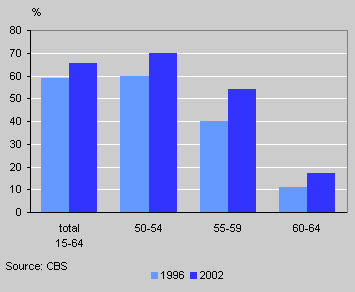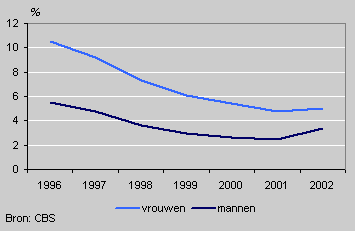Job market turning around in 2002

In 2002 the job market turned around. The growth rate in employment was far less buoyant than in previous years. Unemployment started to increase for the first time since 1994.
Slowdown in employment
In 2002 employment increased far less than in previous years. The number of people working in a job of twelve hours a week or more averaged 7.1 million. This is up 76 thousand on 2001. This increase is low in comparison to previous years when the active labour force increased by between 150 and 200 thousand a year.
Employed labour force, growth rate

Greater participation of women
The increase in employment in 2002 took place exclusively among women. The percentage of women aged 15-64 working in paid jobs for twelve hours a week or more increased to 55. Ten years ago the percentage was 41. The number of men with a job of twelve hours a week or more hardly changed between 2001 and 2002. Labour participation among men aged 15-64 fell to slightly under 77 percent. This was because the number of men in this age group increased.
Participation rate of people over 50

Participation rate of people over 50 continues to increase
The increase in the participation rate of people over 50 is still continuing. Over 70 percent of people aged 50-54 had a job for twelve hours a week or more in 2002. Six years earlier this was 60 percent. The increase was even greater among people aged 55-59, namely from 40 to 54 percent. The participation rate is also increasing among people over 60, although the increase is limited. In 2002 one in six people over 60 held a job of twelve hours or more.
Unemployment by sex

Unemployed labour force increased by 50 thousand in 2002
Between 1996 and 2001 unemployment fell from half to a quarter of a million people. Since the job market turned around in 2002, unemployment increased by 50 thousand, reaching 300 thousand. This is the same figure as in 1999. The unemployment rate reached 4.1 percent. Unemployment among men increased more than unemployment among women. This meant that the difference in unemployment between men and women decreased. For years unemployment among women was twice as high as among men. In 2002 the difference was reduced to one-and-a-half times (3.4 percent for men and 5.0 percent for women).
Jacques Thijssen